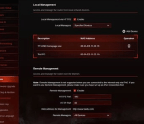PlayStation: Recapturing a lost art









The idea of new games emulating the style of titles from bygone eras is far from rare in the modern gaming landscape. Pixel-art platformers from to , SNES-inspired Metroidvanias like and , and many more besides, have established the indie-driven revival of the 16-bit era as a mainstream aesthetic that sits happily alongside the 3D photorealism that tends to be favoured by the big studios. We know it is possible for styles associated with the past to make a triumphant return. Why is it, then, that the iconic polygonal style associated with the original PlayStation hasn’t yet enjoyed a similar moment? The revival of the low-fi 3D aesthetic associated with that console has been far more low-key. Rather than gracing Game of the Year lists and winning high-profile awards as 16-bit-inspired titles frequently have, you tend to find games with PlayStation-style aesthetics circulating as small experimental projects on indie distribution platform , only the odd title poking its head above the parapet to gain some kind of wider recognition. We spoke to some of the creators behind these games about their reasons for returning to PlayStation visuals, the potential power of the aesthetic and the reasons why it has yet to be fully embraced by the mainstream. When it comes to timing, the nostalgia that helped fuel the 2D 16-bit revival should be right for the PlayStationand as if they had been made in 1998. Toni decided to run with this style to create his surreal horror title , going so far as to stick to the limitations of the original PlayStation to keep the game authentic. “The whole point going in was to create a sort of a ‘lost media’ game,” Toni explains. “I felt the PlayStation look just made sense, since there were a massive amount of really obscure games released for the original PlayStation,” he says, citing the likes of and as inspirations. deliberate use of warped textures, jagged edges and CRT blurriness to invoke an uncomfortable sense of the surreal showcases one of the major strengths of the PlayStation’s visual style. Go back to the games of that era and there is often something unintentionally haunting about those early 3D worlds. Their flat surfaces and rudimentary textures, fading into the darkness or murk of low draw distance, feel uncomfortably sparse. The contrast that the modern wonders of 3D gaming now offer only enhance this sense of uncanny, which perhaps gives us a clue as to why games that use this visual style haven’t yet broken into the mainstream in the same way that pixel-art games have. There is something alienating about them. They make people uncomfortable. Indeed, it is perhaps telling that the horror genre is unusually prevalent among the modern titles that are returning to the PlayStation aesthetic. Alongside Toni’s , there is , a collection of indie horror games presented in the form of a fake PlayStation demo, set to get a sequel in 2021. There is also the inspired (due a sequel in 2021 as well) and the haunting , arguably one of the better known 3D retro titles.
You’re reading a preview, subscribe to read more.
Start your free 30 days





